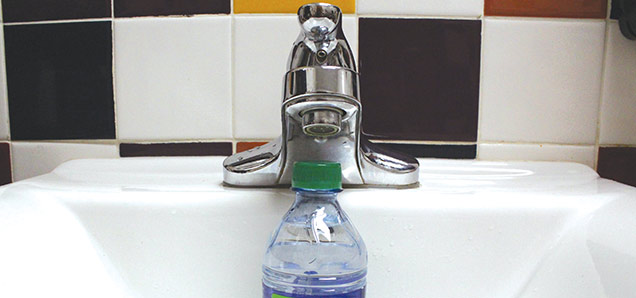Bottled water vs. tap water: What's better?
 CREDIT: STEPHANIE LAI
CREDIT: STEPHANIE LAIWhich do you prefer? Bottled or tap water? Read more about what Kailyn Smith has to say on the subject.
Kailyn Smith is the environmental program co-ordinator.
It seems innocent enough. I am sure you’re busy and on the go, so when all of a sudden you are spitting dust, you’ll do just about anything for that thirst quenching bottle of water from the nearest vending machine or retailer.
But have you ever thought about the journey that bottle of water has taken to get into your hot little hands? What about the chain of threatening ecological impacts that bottled water has spurred? And have you ever thought to yourself, ‘Why am I paying for a resource that flows pretty much for free out of my tap?’
Since the early ‘90s, Canadian consumption of bottled water has increased with over 1.5 billion litres of water produced annually. Single-use bottles are made from polyethylene terephthalate (PET), plastic grade #1, which is derived from petroleum.
The manufacturing process of these bottles requires a number of chemical compounds that are known to be toxic to both human and environmental health.
According to Stewardship Ontario, 44 per cent of our plastic bottles end up in the landfill every year, where they will take hundreds of years to decompose and those harmful chemicals that went into manufacturing the bottle will have plenty of opportunity to leach into our environment.
In addition to contributing to the planet’s growing waste problem, bottled water can have harmful impacts on our resources. Did you know that it takes up to three litres of water in order to produce one litre of bottled water?
Groundwater pumping by bottled water companies draws heavily on underground aquifers and harms watersheds. Not only does bottled water strain our water resources, it also contributes to growing energy consumption and greenhouse gas emissions.
It is estimated that for every ton of PET produced, three tons of carbon dioxide is released to the atmosphere. The manufacturing process for bottled water has been known to emit harmful air emissions, such as acetaldehyde and 1,4-dioxane, which are considered group 2 human carcinogens.
Bottling, labeling and sealing the water can be an energy intensive process. The bottled water also needs to be transported to the market, which can be especially impactful if the water is imported from outside of Canada.
Environmental issues aside, did you know that bottled water costs 1,000 times more than the water from our faucet at home?
Companies like Dasani and Nestle actually admit that they source their water from local or municipal supplies – the same supply your tap water comes from. In Canada, tap water follows stringent regulations set out by the Federal Guidelines for Canadian Drinking Water Quality and is monitored closely. In fact, municipal water in Toronto is checked every four hours for bacteria.
Bottled water is bad for the environment and your pocket.
Did you know that Fanshawe has water filling stations across campus to help you avoid the sins of purchasing bottled water? Our refill stations even have a nifty little counter that will tell you how many bottles have been saved from landfill by filling up your reusable bottle.
To date, over 13,000 bottles have been diverted from landfill at Fanshawe. So help reduce your environmental footprint by opting for filling up your reusable water bottle instead of purchasing single use bottles. If you’d like to learn more, contact us at sustainability@fanshawec.ca.













